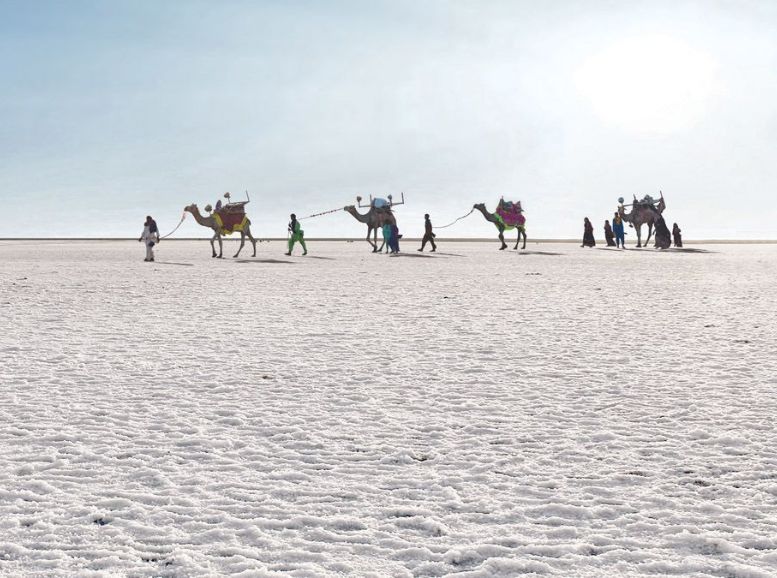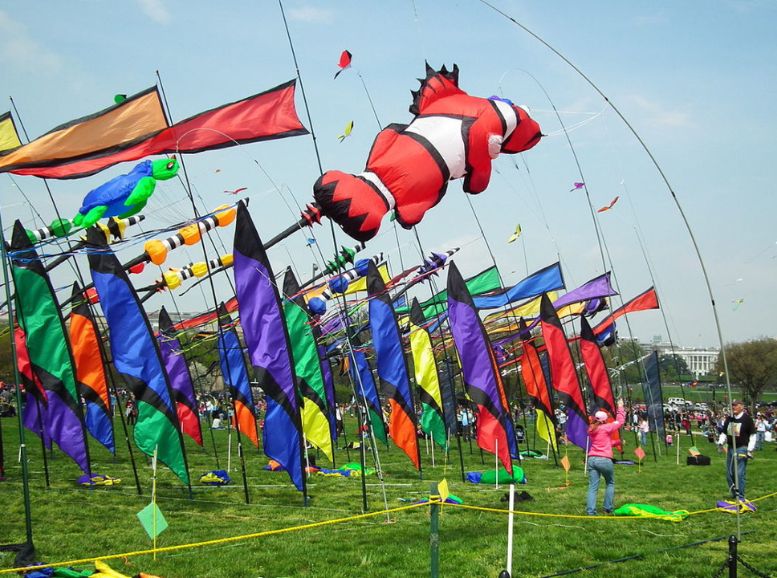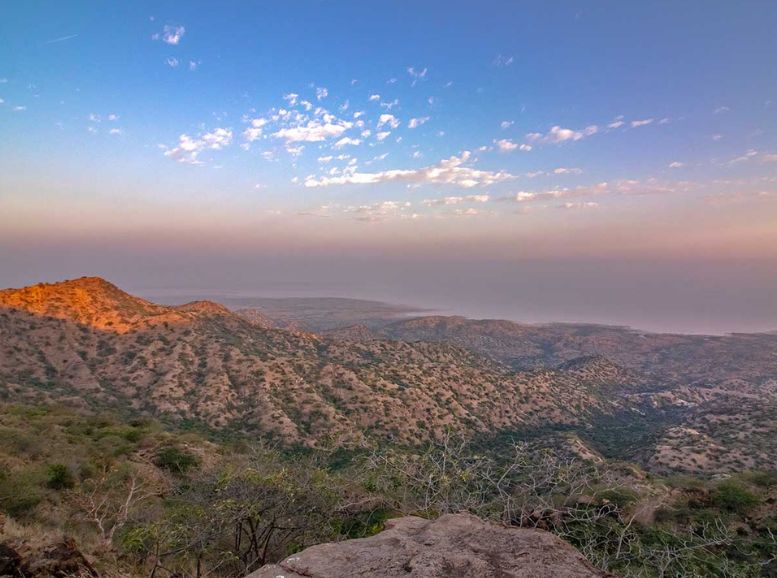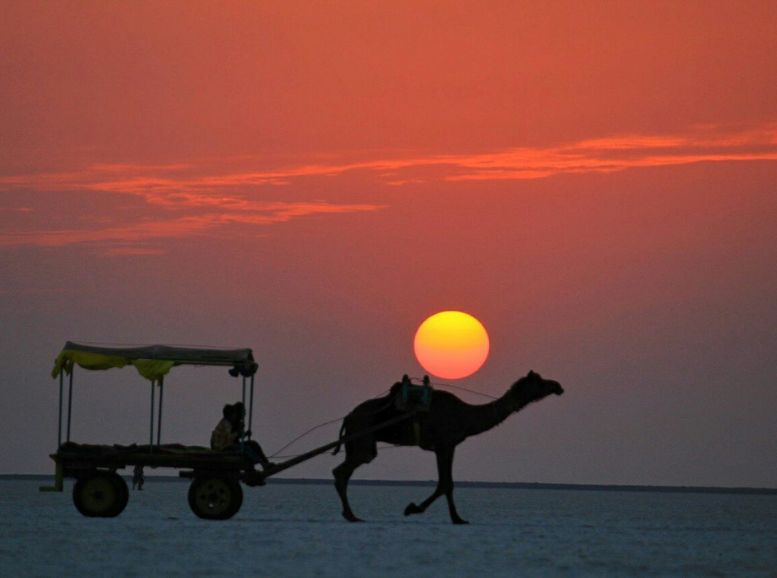Imagine a landscape painted in white, stretching endlessly towards the horizon. This isn’t the arctic; it’s the Great Rann of Kutch, a majestic salt desert that unfolds across Gujarat, India. Spanning a whopping 7,500 square kilometers, it’s more than just a geographical wonder – it’s a vibrant cultural tapestry waiting to be unraveled. Nestled between the whispering Gulf of Kutch and the Arabian Sea, this unique terrain transforms with the seasons, offering a spectacle that’s both otherworldly and utterly captivating.
Join us on this adventure through a land where ancient traditions meet modern charm. Immerse yourself in the rich heritage of the Kutchi people, discover the intricate crafts that tell the stories of their lives, and witness the breathtaking beauty of a place where salt crystals dance beneath the endless sky.
How to reach:
By Air: Bhuj Airport (BHJ) is your gateway to the Rann. With connections to major cities like Mumbai, Delhi, and Ahmedabad, it’s a convenient starting point. Once you land, taxis and buses are readily available to whisk you away to the desert, roughly 80-100 kilometers distant.
By Train: Bhuj Railway Station is another option. Trains from various Indian cities, including Ahmedabad, Mumbai, and Delhi, arrive here. From Bhuj, taxis and buses will take you the rest of the way to the Rann.
By Road:
- Bhuj as your Base: This is the most popular route. From Bhuj, take the Bhuj-Bhachau Road or Bhuj-Gandhidham Road to reach Dhordo or other destinations within the Kutch region.
- A Longer Journey from Ahmedabad: If you’re coming from Ahmedabad, it’s about a 400-kilometer journey. You can drive yourself via NH947, or take a bus to Bhuj and then continue to the Rann.
- Bus Connections: For those in other cities, don’t fret! State-run and private buses connect major hubs like Ahmedabad, Gandhinagar, and Bhuj directly to Dhordo or nearby towns.
Best time to visit:
Winters (November to February): This is the peak season for a reason! With daytime temperatures hovering between a pleasant 12°C to 25°C (54°F to 77°F), winter offers perfect weather for exploring the vast expanse of the white desert. It’s also prime time for the Rann Utsav, a vibrant cultural festival that showcases the region’s traditional arts, music, and dance. And if you’re lucky enough to visit during a full moon, prepare to be spellbound by the ethereal beauty of the shimmering salt flats bathed in moonlight.
Monsoon (July to September): The monsoon transforms the Kutch landscape into a lush green paradise. However, be aware that access to some areas of the Rann might be limited due to temporary flooding. This season is ideal for birdwatchers and those who appreciate the vibrant flora that bursts into life with the rains. However, navigating the Rann during monsoon can be challenging, so be prepared.
Summer (March to June): Kutch summers are no joke! Temperatures can soar above 40°C (104°F), making outdoor activities uncomfortable. The Rann itself can appear dry and barren under the relentless sun. Unless you’re a heat enthusiast, it’s best to avoid visiting during these months.
Attractions:
White Desert Landscape:

The Great Rann of Kutch isn’t just a desert; it’s a shimmering mirage come to life. This endless expanse of white salt stretches as far as the eye can see, a captivating spectacle that feels almost unreal. Spanning thousands of square kilometers, the Rann transforms throughout the day. Under the midday sun, it might be a blinding white canvas, but sunrise and sunset paint it with delicate strokes of pink and gold.
The landscape is starkly beautiful, dotted with salt mounds and crystalline formations that glitter like scattered jewels. It’s a photographer’s dream and a place to truly escape into nature’s minimalist grandeur. As you walk across the hardened salt crust, a sense of awe washes over you.
Rann Utsav:

Imagine a vibrant carnival erupting amidst the stark beauty of the white desert. That’s the Rann Utsav, a dazzling festival held annually from November to February that celebrates the rich cultural heritage of Gujarat’s Kutch region.
Traditionally dressed performers fill the air with the infectious rhythms of Garba and the graceful movements of Raas. Wander through a bustling bazaar overflowing with intricate embroidery, vibrant bandhani textiles, and other stunning Kutchi handicrafts – each piece a testament to the region’s artistic legacy. For a truly unique experience, ditch the usual hotel and embrace the desert nights under a canopy of stars in luxurious tent accommodations.
Kala Dungar (Black Hill):

Kala Dungar, the crown jewel of Kutch, rises majestically as the highest point in the region. On a clear day, its summit offers a breathtaking panorama – the vast expanse of the Great Rann of Kutch shimmering at your feet, and perhaps even a glimpse of the Pakistan border on the horizon. The journey itself is an adventure, a winding path through a landscape dotted with the hypnotic whirring of windmills and the charm of traditional Kutchi villages.
Reaching the top, you’ll be greeted by the Dattatreya Temple, a serene haven dedicated to Lord Dattatreya that welcomes both pilgrims and curious travelers. But the true magic unfolds at sunset. The Rann below transforms into a fiery canvas, ablaze with golden hues that seem to stretch infinitely. Witnessing this spectacle is a moment that stays with you – a spellbinding fusion of nature’s grandeur and the serenity of the vantage point.
Sunset at the Rann:

Witnessing a sunset over the Great Rann of Kutch is pure enchantment. As the fiery orb dips below the horizon, the vast salt flats morph into a shimmering sea of pinks and golds. The transformation is mesmerizing, like watching a silent explosion of color across the landscape. Long, dramatic shadows stretch out, painting the desert floor in a mesmerizing dance of light and dark.
The air hangs still, broken only by the soft whispers of the desert wind, a gentle sigh that carries the distant calls of migratory birds returning home. It’s a symphony for the senses, a prelude to the breathtaking spectacle unfolding before your eyes. The Rann becomes a photographer’s paradise – a canvas splashed with the fleeting beauty of nature’s palette, all set against the backdrop of an endless horizon.
Local Experiences:
Immerse yourself in the Rann Utsav: Witness a dazzling spectacle of music, dance, and local cuisine during this annual festival amidst the stark beauty of the white desert.
Explore Artisan Villages: Journey to Bhujodi, Nirona, and Hodka to witness generations-old craftsmanship in intricate embroidery, leatherwork, and pottery. Take home a unique souvenir of Kutchi artistry.
Savor Kutchi Delights: Indulge in the region’s culinary scene. Sample Kutchi Dabeli, a savory lentil and vegetable mash, and Kutchi Pakwan, a deep-fried flatbread. Don’t miss the vibrant flavors of a traditional Gujarati Thali.
Witness a Magical Sunset: Ascend Kala Dungar, the highest point in Kutch, for panoramic views of the Rann. On a clear day, catch a glimpse of the Pakistan border. Witness the desert transform as the sun dips below the horizon, painting the sky in fiery hues.
Embark on a Wildlife Safari: Take a thrilling safari in the Wild Ass Sanctuary and spot the majestic Indian wild ass, an endangered native species. Look out for diverse birdlife, from vibrant flamingos to pelicans with impressive wingspans.
Unearth Rich History: Explore Bhuj’s Aina Mahal, a dazzling palace adorned with intricate mirrors. Visit Prag Mahal, a majestic sandstone structure showcasing Indo-Islamic architecture. Learn about the region’s past at the Kutch Museum.
Experience Rural Hospitality: Ditch the hotel and stay in traditional Bhungas (huts) in local villages. Immerse yourself in the warmth of Kutchi hospitality and experience the simple life.
Learn Traditional Crafts: Unleash your inner artist! Participate in workshops to learn Rogan painting, tie-and-dye (bandhani), and block printing. Take home a one-of-a-kind creation as a memento of your time in Kutch.
Travel tips:
Winter Wonderland: Aim for a visit between November and February. Pleasant weather lets you experience the Rann Utsav in its full glory and capture unforgettable sunsets against the stark white desert.
Book Smart, Stay Cozy: Booking your tent or hotel well in advance is crucial, especially during the Rann Utsav. Pack layers – light, breathable clothes for the day and warmer options for chilly evenings. Sun protection is essential, so bring sunglasses, a hat, and sunscreen. Comfortable shoes are a must for exploring the desert terrain.
Hydration Hero: The desert can be dry. Carry a reusable water bottle and stay hydrated throughout your visit.
Respectful Explorer: When visiting villages and cultural sites, dress modestly and be mindful of local customs and traditions. Always ask permission before photographing people or their homes.
Limited Connectivity: While major towns have good mobile network coverage, some remote areas around the Rann may have limited or no signal. Plan accordingly.
Eco-Warrior: The Rann’s ecosystem is delicate. Help conserve it by avoiding littering and respecting wildlife and their habitats.
Permits for Foreign Travelers: Foreign nationals might require permits to visit areas near the international border. Obtain these in advance from local authorities.
Explore Further: The Great Rann is a dazzling star, but don’t miss nearby gems like Kala Dungar, wildlife sanctuaries, and cultural landmarks in Bhuj and surrounding villages.
Conclusion
Unveil the magic of the Great Rann of Kutch on Xplro.com. This isn’t just a geographical marvel; it’s a cultural odyssey that immerses you in Gujarat’s rich tapestry. From the ethereal expanse of the white desert stretching beneath a vast sky to the vibrant revelry of the Rann Utsav, every moment here is a testament to the resilience and creativity of the Kutchi people. Witness fiery sunsets paint the salt flats, explore hidden villages brimming with traditional crafts, and tantalize your taste buds with the region’s unique cuisine. The Great Rann of Kutch leaves an indelible mark on all who visit. As you plan your adventure with Xplro.com, remember to embrace the warmth of Kutchi hospitality, respect the land and its traditions, and savor every experience this one-of-a-kind destination offers.
FAQs
When is the ideal time to visit the Great Rann of Kutch?
- The prime time to visit is between November and February, during the cooler winter months when the weather is comfortable and the Rann Utsav festival takes place.
How can I get to the Great Rann of Kutch?
- The closest airport and train station are in Bhuj. From Bhuj, you can hire a taxi or take a bus to reach the Rann, which is around 80-100 kilometers away.
Is a permit required to visit the Great Rann of Kutch?
- Foreign visitors need a permit to access certain areas near the Rann, which can be obtained from local authorities in Bhuj or online. Indian visitors usually do not need a permit for the main tourist zones.
What is the Rann Utsav and when does it occur?
- The Rann Utsav is a vibrant annual festival celebrating the culture of Kutch with music, dance, crafts, and local food. It runs from November to February.
What accommodation options are available in the Great Rann of Kutch?
- Visitors can choose from luxury tents at the Rann Utsav, as well as budget hotels and guesthouses in Bhuj and nearby villages such as Dhordo.
What should I pack for a trip to the Great Rann of Kutch?
- Bring light cotton clothing for the daytime, warmer layers for the evenings, sunglasses, a hat, sunscreen, comfortable shoes, and a reusable water bottle.
What activities can I do at the Great Rann of Kutch?
- Activities include exploring the white salt desert, participating in the Rann Utsav, visiting craft villages, going on wildlife safaris, birdwatching, and sightseeing in Bhuj.
Is the Great Rann of Kutch suitable for family trips?
- Yes, it offers a variety of activities and attractions that appeal to all ages, including cultural experiences, nature exploration, and educational tours.
Are there any health precautions I should take?
- Keep hydrated, use sunscreen, wear a hat and sunglasses, and bring any necessary medications. Consult your doctor if you have specific health concerns.
Can I visit the Great Rann of Kutch during the monsoon season?
- The monsoon season (July to September) changes the landscape, but some areas may be inaccessible due to waterlogging. It’s best to check local conditions before planning a visit during this time.
What are the must-see attractions in and around the Great Rann of Kutch?
- Key attractions include the white salt desert, Kala Dungar (Black Hill), wildlife sanctuaries, craft villages, and historical sites in Bhuj like Aina Mahal and Prag Mahal.
How can I support local communities during my visit?
- Support local communities by buying crafts directly from artisans, staying in local accommodations, participating in cultural activities, and respecting local customs and traditions.





